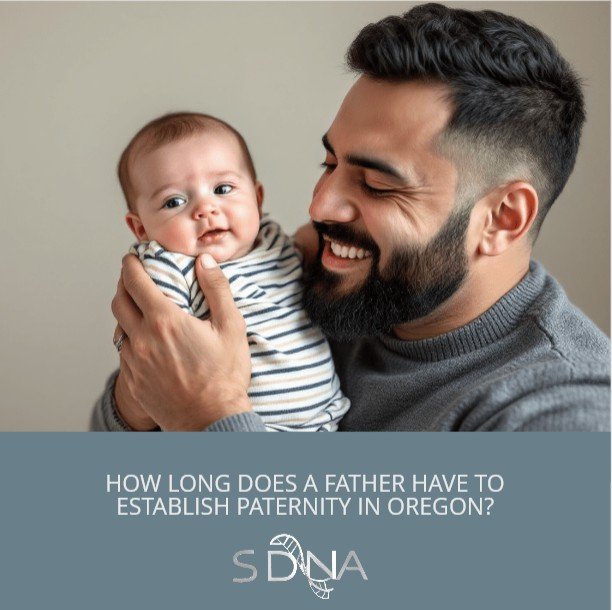
In Oregon, paternity can be legally established anytime before the age of 18. Below is a brief guide on how paternity is established in Oregon.
Who Can Start the Process?
The mother, potential father, or a legal representative of the child may initiate the paternity establishment process. The main methods include:
- Signing an Acknowledgement of Paternity form.
- Independent genetic testing by both parents agreeing.
- Or, the state or legal guardian of the child can file a paternity action on the child’s behalf.
How to Establish Paternity in Oregon
For Married Couples
- Paternity is automatically established when the parents are married at the time of the child’s birth.
- No further action is necessary.
For Unmarried Parents
Unmarried parents can establish paternity through one of two methods:
- Voluntary Acknowledgement of Paternity (AOP)
- Both parents can sign the AOP form, usually at the hospital after birth or later at the local registrar or paternity registry office.
- The Acknowledgement of Paternity is legally binding once signed and filed with the Oregon Center for Health Statistics/The State Registrar of the Center for Health Statistics.
- Signing this form establishes legal paternity without court involvement.
- Court Petition
- If the parents disagree about paternity, either parent can file a petition with Family Court.
- After the court accepts the petition and schedules a hearing, a judge may order genetic testing to determine paternity.
Time Limits and Legal Effects
The alleged father, mother or legal guardian of the child has up to the age of 18 years of age to establish paternity. Below are circumstances in which paternity action may occur and legal effects for acknowledgement.
- The father is required to pay child support.
- The father may receive visitation rights.
If the child doesn’t have a presumed, acknowledged, or legally confirmed (adjudicated) father, anyone can start a legal process to establish paternity up to the age of 18.
If the child already has a legally confirmed father through a court decision, only someone who was not involved in that original case can start a new case to prove paternity. This new case must be brought within two years from the date of the original court decision.
Presumption of Paternity in Oregon
A man is presumed to be the legal father if:
- He is married to the mother when the child is born.
- The child is born within 300 days after the marriage ends.
This presumption applies even if the husband is not the biological father.
What You Need to Know Before Signing a Voluntary Acknowledgement of Paternity Form
Before signing an Acknowledgement Paternity form (at a hospital or child support office), both parents must:
- Receive written and oral information about:
- Available alternatives.
- Legal rights and responsibilities.
- Consequences of signing the document.
- Have the opportunity to review all information privately, without the other parent present.
- An alleged father or mother is under 18 years of age can sign a acknowledgement of paternity form.
Important: After signing, the AOP form is legally binding and no further court action is required to establish paternity.
Can Paternity Establishment Be Rescinded in Oregon?
Yes. Oregon allows paternity rescission under specific conditions and time-frames.
Within 60 Days of Signing
Both parents must:
- Sign a Rescission of Voluntary Acknowledgment of Paternity
- File with Ohio Office of Vital Records
After 60 Days (Up to One Year)
File a court action proving one of these conditions:
- Duress: Coercion or threats at time of signing
- Material fact mistake: Incorrect information that would have changed the decision
- Fraud: Intentional deception about paternity
Court filing deadline: One year from paternity establishment date.
Important Restrictions
- Mother cannot rescind paternity alone after signing
- No rescission allowed after one year expires
- Court must approve all post-60-day rescissions
Required Documentation
- Original Acknowledgment of Paternity
- Rescission forms (available from ) State Registrar of the Center for Health Statistics
- Supporting evidence for fraud/duress/mistake claims
Establishing Joint Legal Custody for Unmarried Parents
Custody Types
- Physical Custody: Determines where the child lives.
- Legal Custody: Determines decision-making authority over education, healthcare, religion, and access to records.
Default Custody Status
- The mother automatically has physical custody unless a court orders otherwise.
- The mother has sole legal custody by default.
Requirements for Joint Legal Custody
Unmarried parents must:
- Complete a AOP form.
- Obtain genetic test results from an accredited laboratory confirming biological paternity.
Important:
- When genetic testing proves that the man who signed the AOP form is not the biological father, he remains the legal father unless joint custody is voided by court order.
- The mother retains sole legal custody in such cases.
Benefits of Establishing Paternity in Oregon
For the Child
- Financial support from both parents.
- Access to father’s health insurance.
- Inheritance rights through the father.
- Access to father’s family medical history.
- Eligibility for Social Security benefits.
For Parental Rights
- Both parents participate in child-naming decisions.
- Father gains legal recognition.
- Establishes a foundation for custody arrangements and visitation rights.
For Legal Implications
- Enables enforcement of child support.
- Creates legal basis for parental responsibilities.
- Protects father’s right to involvement in the child’s life.
- Provides documentation needed for government benefits.
Note: Married fathers do not need to establish paternity because they are presumed legal fathers if married when the child is conceived or born.
How to Get a Court-Ordered Paternity Test in Oregon?
Paternity can be established through:
- Court Process: Filing a petition requesting a court-ordered DNA test.
- Mutual Agreement: Both parents agree to testing without court involvement.
Requirements:
- Only tests performed by our partner AABB-accredited laboratory will be recognized for legal use in court.
- Test results establish biological relationships accepted by Family Court in Oregon.
Why Choose Secure DNA Tests Oregon?
Secure DNA Tests Oregon offers:
- Personalized service tailored to your needs.
- Partnerships with AABB-accredited laboratories nationwide.
- Trusted by family law attorneys, courts, and medical professionals.
For reliable and accurate DNA testing services, call Secure DNA Tests at 888-970-4211 to get started today.
Do I Need a Lawyer for a Court-Ordered Paternity Test in OR?
No. Either parent can file a paternity petition with Family Court without a lawyer. The judge may order DNA testing to confirm paternity.
Does Signing a Birth Certificate Establish Paternity?
No. Unmarried parents in Oregon establish legal paternity by signing a Voluntary Acknowledgement of Paternity form. The form gets filed with the Oregon Office of Vital Records.
The signed AOP form establishes paternity of the child. This allows adding the father’s name to the birth certificate. The birth certificate alone does not establish legal paternity for unmarried fathers. This allows adding the father’s name to the birth certificate. The birth certificate alone does not establish legal paternity for unmarried fathers.lows adding the father’s name to the birth certificate. The birth certificate alone does not establish legal paternity for unmarried fathers.
Paternal Services:
Home Paternity Test
Legal Paternity Test
Prenatal Paternity Test
Parentage DNA Testing
DNA Testing Services:
Sibling DNA Test
Grandparent DNA Test
Avuncular DNA Test
Maternity DNA Test
Forensic DNA Services:
Infidelity DNA Test
DNA Testing w/Hair
DNA Testing w/Toothbrush
